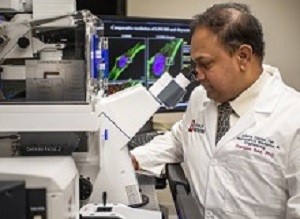
US researchers have developed of a dressing that uses an electric field to disrupt biofilm infection.
Researchers at Indiana University School of Medicine have found a way to charge up the fight against bacterial infections using electricity. Work conducted in the laboratories of the Indiana Centre for Regenerative Medicine and Engineering, Dr Chandan Sen and Dr Sashwati Roy has led to the development of a dressing that uses an electric field to disrupt biofilm infection.
Bacterial biofilms are thin, slimy films of bacteria that form on some wounds, including burns or post-surgical infections, as well as after a medical device, such as a catheter, is placed in the body. These bacteria generate their own electricity, using their own electric fields to communicate and form the biofilm, which makes them more hostile and difficult to treat. The US Centres for Disease Control and Prevention estimates 65% of all infections are caused by bacteria with this biofilm phenotype, while the National Institutes of Health estimates that number is closer to 80%.
Researchers at IU School of Medicine are the first to study the practice of using an electric field-based dressing to treat biofilms rather than antibiotics. They discovered the dressing is not only successful in fighting the bacteria on its own, but when combined with other medications can make them even more effective. This discovery has the potential to create significant changes in the way physicians treat patients with bacterial infections which are resistant to antibiotics. The dressing can also help prevent new biofilm infections from forming in the future. The dressing electrochemically self-generates 1 volt of electricity upon contact with body fluids such as wound fluid or blood, which is not enough to hurt or electrocute the patient.
"This shows for the first time that bacterial biofilm can be disrupted by using an electroceutical dressing," said Dr Chandan Sen, director of the Indiana Centre for Regenerative Medicine and Engineering and associate vice president of research for the IU School of Medicine department of surgery. "This has implications across surgery as biofilm presence can lead to many complications in successful surgical outcomes. Such textile may be considered for serving as hospital fabric – a major source of hospital acquired infections"
Marketing of the dressing for burn care was recently approved by the US Food and Drug Administration. The team is now studying the device's effectiveness in patients recovering from burns.
Abstract
Objective: This study was designed to employ electroceutical principles, as an alternative to pharmacological intervention, to manage wound biofilm infection. Mechanism of action of a United States Food and Drug Administration-cleared wireless electroceutical dressing (WED) was tested in an established porcine chronic wound polymicrobial biofilm infection model involving inoculation with Pseudomonas aeruginosa PAO1 and Acinetobacter baumannii 19606.
Background: Bacterial biofilms represent a major wound complication. Resistance of biofilm toward pharmacologic interventions calls for alternative therapeutic strategies. Weak electric field has anti-biofilm properties. We have previously reported the development of WED involving patterned deposition of Ag and Zn on fabric. When moistened, WED generates a weak electric field without any external power supply and can be used as any other disposable dressing.
Methods: WED dressing was applied within 2 hours of wound infection to test its ability to prevent biofilm formation. Alternatively, WED was applied after 7 days of infection to study disruption of established biofilm. Wounds were treated with placebo dressing or WED twice a week for 56 days.
Results: Scanning electron microscopy demonstrated that WED prevented and disrupted wound biofilm aggregates. WED accelerated functional wound closure by restoring skin barrier function. WED blunted biofilm-induced expression of (1) P. aeruginosa quorum sensing mvfR (pqsR), rhlR and lasR genes, and (2) miR-9 and silencing of E-cadherin. E-cadherin is critically required for skin barrier function. Furthermore, WED rescued against biofilm-induced persistent inflammation by circumventing nuclear factor kappa B activation and its downstream cytokine responses.
Conclusion: This is the first pre-clinical porcine mechanistic study to recognize the potential of electroceuticals as an effective platform technology to combat wound biofilm infection.
Authors
Kasturi Ganesh Barki, Amitava Das, Sriteja Dixith, Piya Das Ghatak, Shomita Mathew-Steiner, Elizabeth Schwab, Savita Khanna, Daniel J Wozniak, Sashwati Roy, Chandan K Sen
[link url="https://www.sciencedaily.com/releases/2019/05/190517173456.htm"]Indiana University material[/link]
[link url="https://insights.ovid.com/crossref?an=00000658-201904000-00024"]Annals of Surgery abstract[/link]
